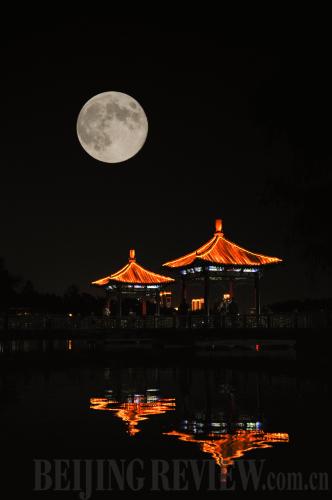|
 |
|
PERFECTLY ROUND: The moon viewed from Nanhu Park in Changchun, capital of northeast China's Jilin Province on September 30, Mid-Autumn Festival of 2012 (ZHANG NAN) |
Today, when asked what Mid-Autumn Festival means, the first thing that many Chinese people would mention is looking at the full moon while eating mooncakes. However, the festival's roots are about much more than just this.
Each of the four seasons lasts for three months according to the traditional Chinese lunar calendar, with autumn taking place during the seventh, eighth and ninth months of the year. Mid-Autumn Festival, as its name would suggest, marks the middle of autumn, and is held on the 15th day of the 8th month on the traditional Chinese lunar calendar, which is always a full moon.
Mid-Autumn Festival is considered the second most important traditional festival celebrated in China after Spring Festival and it is celebrated across the whole of China—not only by the Han people, but also many of China's ethnic minorities.
The legends of Chang'e
There are multiple legends and stories associated with Mid-Autumn Festival and in particular how Chang'e, the moon goddess, came to be on the moon where she now lives. Although the details and events vary wildly, they are all based around the love between the legendary archer Hou Yi and Chang'e.
One such legend can be found in the philosophical classic Huainanzi, written during the Western Han Dynasty (202 B.C. - A.D. 9). In the Huainanzi, it is said that one day, 10 suns rose in the sky and heat scorched the earth until Hou saved the day by shooting down nine of them with his bow. For his heroism, he was awarded the elixir of life, a pill able to grant immortality, by the emperor. He and his beautiful wife, Chang'e, hid it in a locker so as to keep it safe. However, the villain Peng Meng had seen everything and when Hou went hunting, Peng took his sword and forced Chang'e to give him the elixir, threatening to kill her if she did not. In order to stop the evil Peng from taking the elixir and becoming immortal, Chang'e swallowed it herself and began floating into the sky until she landed on the moon, where she met the Jade Rabbit who lives on the moon mixing herbs to make medicine and elixirs.
On the anniversary of Chang'e's flight to the moon on the 15th day of the eighth lunar month, Hou would lay out a table in his backyard and place on it his wife's favorite desserts and fruits in her honor. When people learned of Chang'e's flight to the moon, they did the same as Hou in remembrance of Chang'e and also to pray for her happiness and blessings. This tradition has been passed on from one generation to another through history ever since.
However, not all legends have to do with Chang'e's ascent to the moon. According to another legend, toward the end of the Yuan Dynasty (1271-1368), people could no longer tolerate the oppressive rule of the government and they planned an uprising. They passed on small round cakes with pieces of paper inside bearing calls for revolt from family to family. On the night of Mid-Autumn Festival, the rebel army known as the red turbans attacked the city of Khanbaliq, now called Beijing, and they overthrew the Mongol rulers, establishing the Ming Dynasty (1368-1644). From that day forward, people eat mooncakes every year to mark the rebel victory.
The customs
"Mid-Autumn Festival has its basis in astronomy, with the celebrations occurring during the autumn equinox. This is when sunlight falls perpendicular to the equator—meaning the Earth is not tilted on its axis—and this divides the day and night into equal length in both the southern and northern hemispheres," explained Chen Jianguo, a scholar at the Chinese Folk Literature and Art Society.
|
